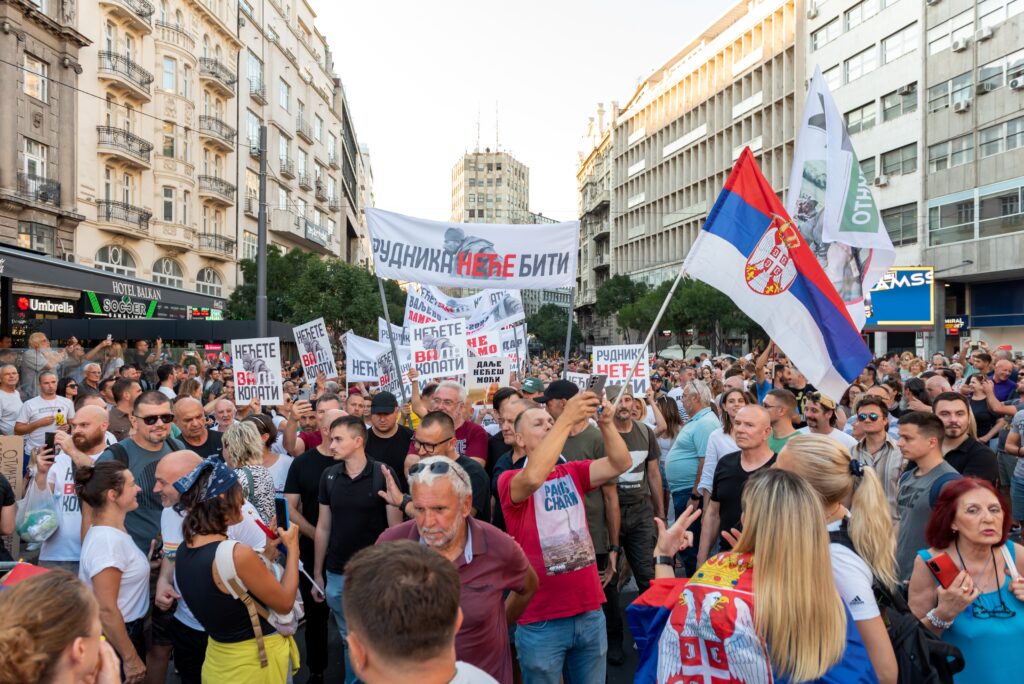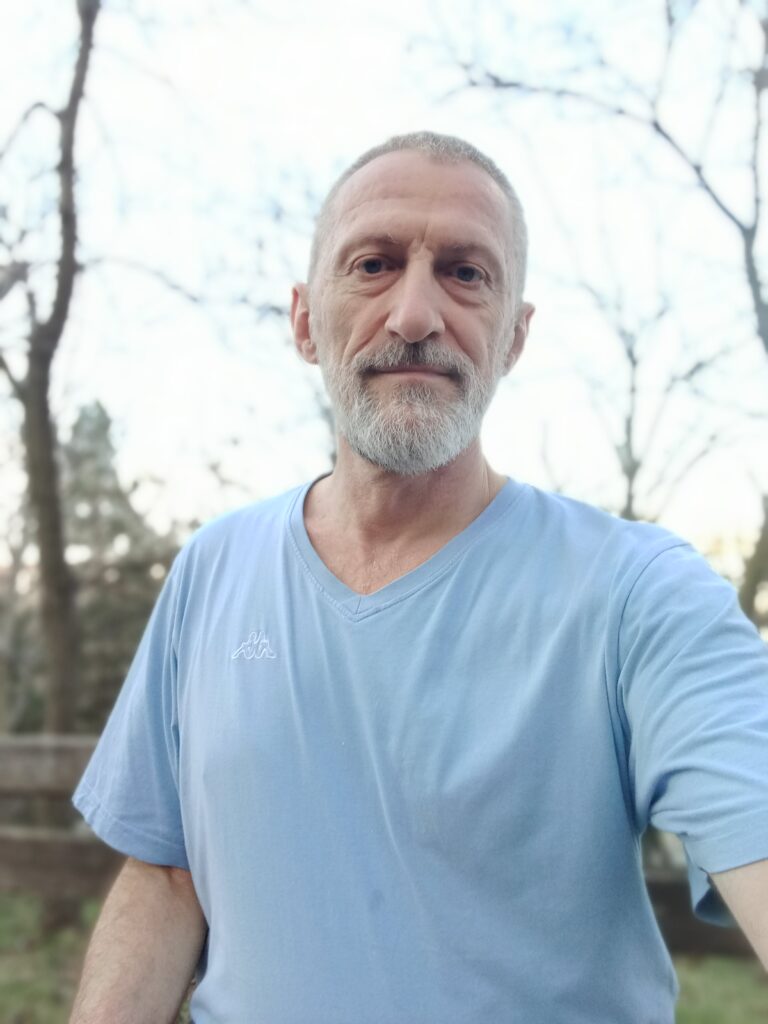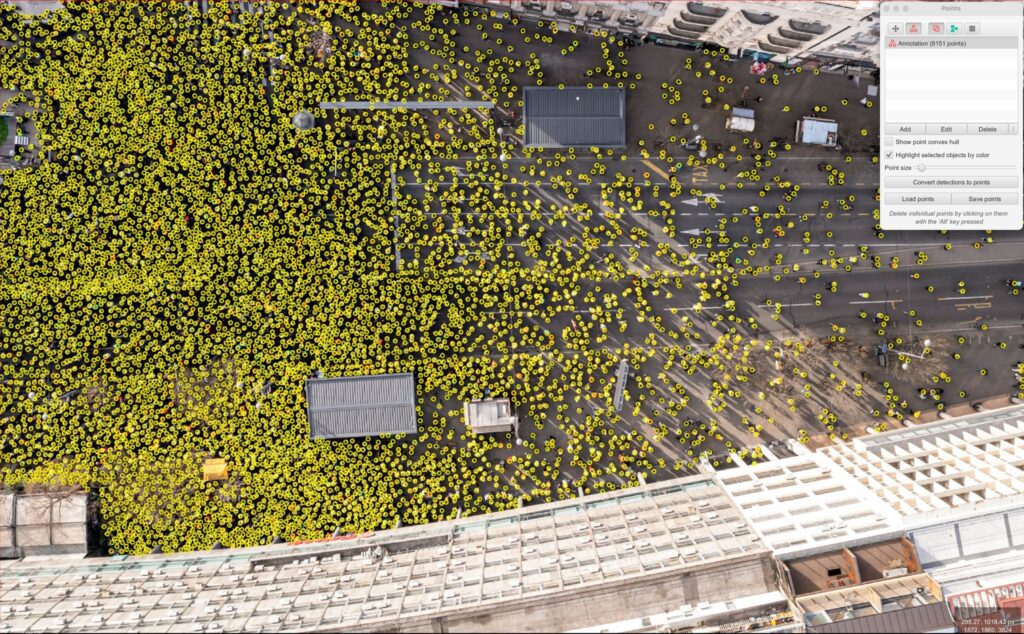The right to protest is one of the fundamental principles of democracy

In Serbia, protests against lithium mining are being held, and their large scale has surprised both the authorities and seemingly the protesters themselves. After each protest, we have precise data on the number of attendees thanks to the Public Assemblies Archive. On this occasion, we spoke with cultural and media activist Aleksandar Gubaš, who made a comparison between the gatherings from the 1990s and these new ones.
You describe yourself as a passionate protest crowd counter since 1991. How did it look back then, and how does it look now with modern technology?
The biggest technological leap in this field was brought by the advent of smartphones, not crowd-counting software, as is often mistakenly believed. The software is somewhat mystified, and we avoid it at the Archive of Public Gatherings because our initial experiences showed it can be quite error-prone. That’s why we still stick to the tried-and-true method of manually marking people in pictures, using the software only for automatic counting. More useful than the software is the ability to video and photo record every gathering, which mobile phones have made possible, allowing us to count and analyze the footage endlessly. In the 1990s, we could only count as accurately as our naked eye allowed on the spot.
What is the difference between those gatherings in the 1990s and the modern ones?
The biggest technical difference is the existence of social networks, which has somewhat reduced the motivation to take to the streets because there is now the possibility of experiencing the protest indirectly through live broadcasts. However, it should be noted that mobilizing protesters has now become much more accessible and democratic, as anyone can call people through social networks, which is how important protests in 2017 and 2020 were organized.
The biggest political difference compared to the Milosevic era is that back then, there were strong opposition parties with authority and infrastructure on the ground, whose calls people would respond to without much hesitation. Today, no opposition party has even close to the same capacity, and all have significantly exhausted their credibility by stringing together failures and repeating mistakes over the last 7-8 years. During that time, other entities, such as environmental organizations, groups of public figures, or neighbourhood movements against investor urbanism, have emerged as credible, effective, and popular protest organizers, entities that did not exist at the end of the last century.
Even if it doesn’t directly lead to a change of power, the crowd on the street certainly has great potential to achieve the adoption of some demands of the protesters.”
The right to protest is one of the fundamental principles of democracy. What does “the street” mean to you in the context of “gaining/losing power on the street”? Does “the street” really have such power?
In our tradition, we don’t have such popular revolutions as recently seen in Bangladesh. In Serbia, the overthrow of power by people taking to the streets is only a reaction to something that has already been resolved in other spheres, like the military coup in March 1941 or the presidential elections in September 2000. Here, the crowd does not overthrow power on the street by itself, and I don’t see any real plans for that either.
However, even if it doesn’t directly lead to a change of power, the crowd on the street certainly has great potential to achieve the adoption of some demands of the protesters and can seriously shake the positions of power if the protest organizers make smart moves. There are successful examples of this in our practice.
The government tends to downplay the significance of protests and uses police data on the number of protesters, which is usually far lower than the actual count. On the other hand, organizers often inflate these numbers. What is the secret to your credibility in the public eye, and do both sides trust you?
Our methodology is completely transparent and detailed on our website, as well as in various media outlets. It is something entirely verifiable, and anyone willing to spend two or three hours counting can verify any of our estimates using the available material.
I believe that even those who haven’t delved into our methodological explanations understand that the figures presented by the Archive of Public Gatherings are based on a structured system and a consistent scale, which alone is enough to foster a different kind of relationship with our estimates. People see that these numbers are not made up on the spot: they may be lower or higher than what they think they should be, but they are consistently so, and I believe that this principled approach is noticeable.
Moreover, common sense suggests that the real figures, likely similar to ours, always fall somewhere between the numbers presented by the opposing sides.
I think people also recognize our seriousness in the fact that, unlike President Vučić, who likes to present supposedly very precise numbers, we never offer exact headcounts. Instead, we always round to tens, hundreds, or thousands, depending on the scale of the gathering, and often provide a range from to. Protests and public gatherings are too dynamic, complex, and fluid to give a headcount with absolute precision.
The estimate heavily depends on the available material, its technical quality, and the timing of the footage. We do not shy away from updating our estimates if we receive better-quality material, and I think this also helps build trust. We understand that the path to truth is often not straightforward, but we are committed to establishing it objectively, whether we like it or not.
We believe that the truth is very useful, especially for protest organizers, as it highlights strengths that should be leveraged and weaknesses that need to be addressed. I think we have already helped many—participants, organizers, and analysts alike—to develop a realistic understanding of the scale and significance of turnout at a protest.
However, we also often have to “burst the bubble” for many who still believe in myths about hundreds of thousands of people taking to the streets of Belgrade, Prague, or Tel Aviv because that simply doesn’t happen in cities of this size in the political realm. But there’s no need for that because significant changes can be achieved with far fewer people when other factors align.

From your experience, how would you characterize the recent protest against lithium mining held in Belgrade at the beginning of August?
In terms of mass turnout, it was one of the largest gatherings in the history of Belgrade, which is particularly impressive considering it was organized in the middle of the vacation season and under pressure on activists. It’s also worth noting that this grassroots, self-organized gathering was larger than the largest political rally that the current state apparatus has ever managed to organize. When we add the even more impressive turnout in smaller towns, it is clear that we are witnessing an organic national resistance to lithium mining in our fields and graves. This is something that all interested parties should take seriously.
Although smaller in number of participants, protests in small towns are often more impressive. Why is that?
In a small town, it is not possible to gather as large a crowd as in Belgrade, but the situation with lithium has shown that it is possible to mobilize a much larger percentage of the local population in smaller towns than in larger cities. One explanation is certainly the degree of vital interest: people whose fields are directly affected surely have a much stronger motive to attend these protests than residents of large urban areas who never even see those fields.
In smaller towns, it is generally thought that it takes more courage to come out and protest, which is certainly true, but in small towns, other factors are also at play, making the situation less linear. For example, it is easier to find out about a protest even without the media because it is much more visible—everyone in a small town sees and hears when something happens in the main square. Moreover, getting to the protest location takes less time in small towns than in Belgrade, so a smaller percentage of people back out. Therefore, such things should also be considered when comparing turnout in towns of different sizes, but in this story about lithium, the degree of vital interest certainly stands out as an exceptionally strong factor.
Common sense suggests that the real figures, likely similar to ours, always fall somewhere between the numbers presented by the opposing sides
Which protests this summer were “impressive” in the categories of small and medium-sized towns?
More than a fifth of the local population turned out in many small towns: Gornja Dobrinja, Bresnica, Mionica, Osečina, Rekovac, Bogatić, Kosjerić. In Gornja Dobrinja, more than two-thirds of the village participated in the protest. In many of these places, these were the largest protests ever organized. As for towns with more than 20,000 inhabitants, the best turnout was in Šabac and Gornji Milanovac.
It is interesting that in none of these places have there been any specialized rallies in support of lithium mining. Such sentiment seems to not exist at all in Western Serbia, neither spontaneously nor induced.

How do you assess the media coverage of street protests? Despite the frequent media blackouts, can the truth about protests reach the majority of citizens?
I believe that a large part of Serbia’s population does not have a very clear idea of what lies behind a protest, and due to the media blackout, most probably don’t even know that a protest has taken place. However, during these recent protests against lithium, it was clear that the local population’s response was enormous, even in places where United Media doesn’t reach. This tells us that information about something that genuinely threatens people will somehow find its way to those affected, especially when the problem directly impacts their fields, yards, and homes. In such cases, fear drives people to activate various informal communication channels spontaneously at the local level.